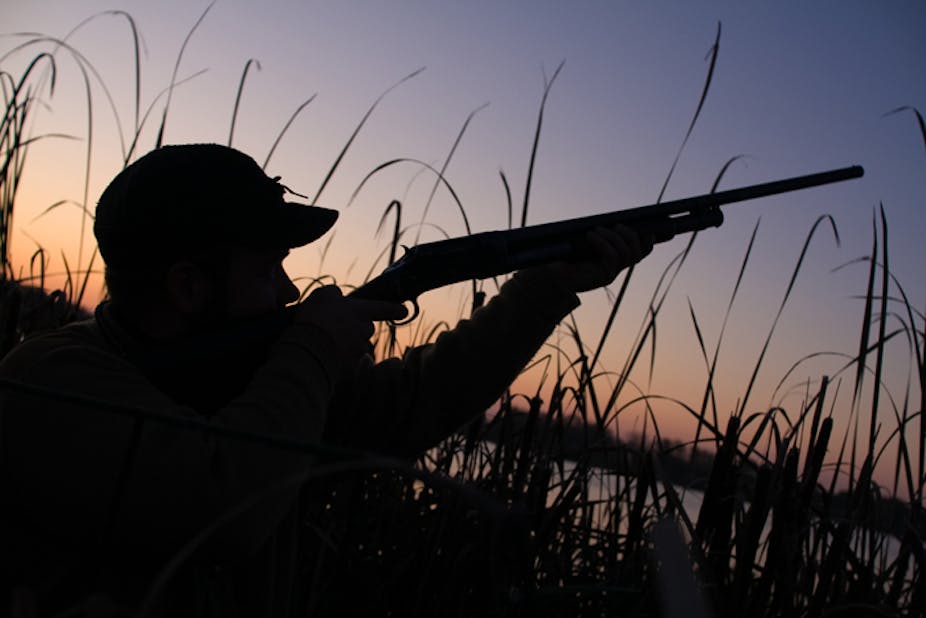There are few issues as divisive in eastern Australia as duck hunting. And 2011 has been one of the most vitriolic seasons yet.
The season opened in Victoria with news that a protester had been shot in the face by a hunter who was just 14 years old. Since then, debate has raged across the airwaves and wetlands of the state - should we be sanctioning the hunting of wild ducks?
If we believe opinion polls, most people abhor duck shooting; seventy-five percent of Victorians polled in 2007 wanted it banned. But a strong hunting lobby maintains that traditional duck hunting has a place in pluralistic society.
The history of hunting
Humans have hunted ducks since the time of the pharaohs but modern recreational duck shooting began in the 16th century, soon after the invention of the gun. European colonists brought duck hunting to Australia and by the late 19th century, 159,000 ducks were passing through the Melbourne markets in a year.
Governments soon started to declare open seasons for duck shooting, initially for most of the year (244 days) but this became increasingly restricted, down to today’s three months, beginning in March.
Hunting is timed to be outside the breeding and moulting seasons. Most ducks in southeastern Australia breed in spring and then become flightless, moulting and renewing their feathers.
Aside from these constraints, governments have to decide whether to declare a duck hunting season each year. This becomes the political flashpoint for claims and counter claims around animal welfare, conservation and hunting traditions.
Sustainable shooting?
The pro-duck shooting camp argue that their pursuit is founded on sustainability: duck shooting primarily kills newly bred ducks, most of which would die anyway.
Overseas research generally supports the contention that young birds are more naive and more likely to be shot than experienced adults.
In the parlance of duck research, the big question is whether duck hunting compensates or adds to natural death rates.
Hunters also argue that their pursuit is steeped in tradition with considerable skills developed over generations.
They often liken duck shooting to fishing where skills and traditions have developed and the quarry is also consumed.
Finally, there is the conservation argument. Hunters the world over are primarily interested in ensuring they can continue to hunt and they know that, without habitat protection and creation, opportunities are diminished.
For the birds
The anti-duck shooting camp argue strongly on animal welfare grounds. Shotguns rely on a spray of small pellets that fan out and collide with the flying duck. Shotguns have a limited range and rely on enough pellets hitting the duck to fatally wound it.
This does not always happen and a duck may have sufficient mobility to escape and die later, even if the shot brings the bird down. Hunters often use dogs to quickly retrieve many of the wounded birds.
Their conservation argument focuses on the effects of duck shooting on populations of the eight game species in southeastern Australia.
In the past, lead poisoning of ducks and other waterbirds was a problem. Lead pellets from shotguns would lie dormant in the wetland where they were later picked up by ducks, mistaking them for small rocks which they normally eat to grind up of their food. Steel pellets are now used.
Finally, there was considerable concern that non-target species, including rare species, were also shot.
Education and identification tests have significantly improved this problem from the early 1990s where for example, more than 200 waterbirds from 24 non-target species, including grebes, rare freckled duck, herons and swans, were shot on two wetlands in NSW.
Anti-duck shooting groups have successfully campaigned for the banning of recreational duck shooting in Western Australia, New South Wales and Queensland.
Wounding of ducks represents the most difficult issue for duck hunters to counter. Inevitably, some ducks shot are wounded and some of these will not be despatched immediately.
On the other side, conservation of species is the most difficult argument for opponents to sustain. As with global biodiversity, habitat loss is causing duck populations to decline.
Many of the rivers of the Murray-Darling no longer flood as frequently or extensively as they used to. This limits feeding and breeding habitats for ducks: less wetland means fewer ducks.
Hunters in Australia have not usually argued as strongly as some of their northern hemisphere counterparts for river and wetland conservation even though local wetland conservation by hunter groups happens.
How do we decide?
Each year, governments decide whether to declare duck opening seasons on conservation grounds. They use long-term aerial surveys, rainfall, flooding indicators and surveys of wetlands. They also collect data after the event, surveying the numbers and species shot each year – the ‘bag’ surveys.
Widespread rain and flooding in 2010 created the largest area of waterbird habitat since possibly the mid 1970s, and duck numbers and importantly breeding records shot up during annual aerial surveys.
There should be plenty of ducks around, many more than last year and their populations will be spread out to Lake Eyre. Despite this, decision-making for duck hunting in Australia remains rudimentary, lagging sophisticated approaches used by northern hemisphere managers.
There is little knowledge of the true impact of duck hunting on different species. We don’t know how much breeding occurs each year so it is difficult to decide how many ducks can be sustainably shot.
In 2010, the Victorian government laudably developed an adaptive scientific modelling approach to duck shooting. This relied on answers to key questions to build understanding of the underlying drivers of duck conservation.
Unfortunately, management of duck shooting remains a business as usual approach. Little is learned about the long-term impacts of hunting or loss of wetlands and anyone can peddle their pet theories. It seems the politics will continue to be ugly.

